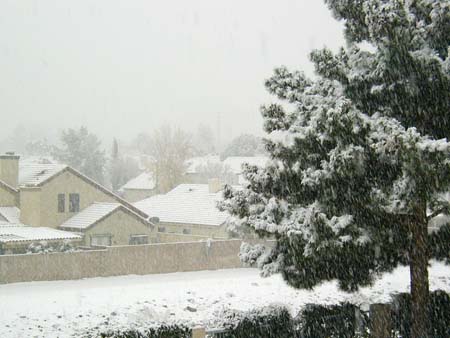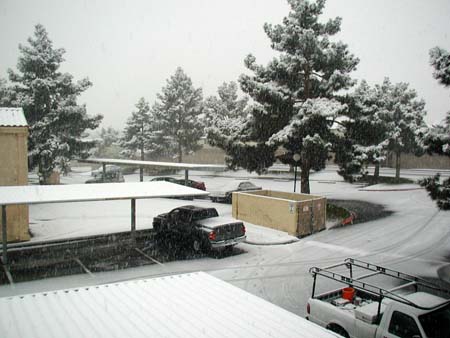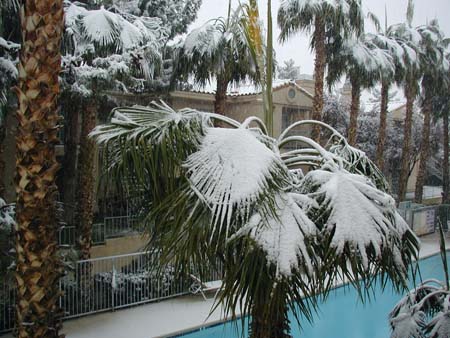



“That’s impossible. We live in Las Vegas.”
Sorry, but daddy is right. The city where your Uncle Dave lives and it regularly gets to 115 in the summer was buried in snow today. The photos above are ones I took from my apartment balcony this afternoon. What the hell happened to global warming?!?
Both roads to California are closed. Airlines canceled flights. 3-6″ on the valley floor, 1-2 feet in the mountains by morning. Biggest snow storm in 41 years, according to one local TV station, although it’s starting to melt, then freeze at 6pm. While people from, say, Buffalo wouldn’t even notice it’s snowing at these levels, no one here (except ex-snow state escapees like yours truly) knows how to drive in it.
How’s it by you?















Got snow here in South Louisiana last Thursday. Not the, pitiful flakes floating downward as they evaporate 18″ above the ground, but a real stick to the cars & ground, slushy road snow. The first time in ~30 years.
I still call bullshit on “global warming”.
Good !!! You need the water in Nevada and Cali !!! Say a prayer of thanks to El Nino !!! At least it wasn’t rain which turn those hillside homes in Cali into MOBILE HOMES !!!
Actually, most models of Gobal Warming talk about years of extreme temperature swings. So snow in Las Vegas fits the models.
I’d like to see pictures of the strip covered in snow.
Malibu….Snow
Yeah, you’re really “buried” in snow. I love how a couple inches shuts everything down in the south.
Okay… I’ve live in quite a few places that have snow, but now I live in Florida… I laugh the day I see that around me down here.
One word “Snow Strippers”. Okay, two words.
Damn you, Al Gore, with your global warming!!
Obama, why hast thou forsaken us?
#7. I saw the temperatures dip into the low 30’s in Miami back in ’92. It can happen.
Har! I’ll tell you what happened to global warming… it’s in Florida. It was in the 80s again today. I’m running the air-conditioning.
That is a dusting of snow in those pics. Not 3 to 6 inches.
When you talk about your Dick. I guess, It’s a foot and a half long.
Amateurs… I live in Ottawa and got 6 inches of snow today. That is on top of the other 2 feet we have had over the last 2 weeks… Oh, and winter is just starting!
The dusting you got in Vegas wouldn’t get the city crews out of the garages here…
But then, we don’t have other extreme stuff like hurricanes, tornadoes, earthquakes, volcanoes or tsunamis… 🙂
We hit -18F yesterday with a windchill of -33F here in Minnesota.
I had to cancel my tennis match.
In Henderson (suburb of Vegas), we have 6″ on the ground and it’s still coming down in sheets.
What part of Vegas are you in Dave?
3 inches last night with 6 predicted for tommorow night below zero wind chill.The good news is all the bums head south this time of year.I’ll be leaving January 2.Happy New Year all you old geeks out there in Dvorakland.
I’ve been teaching my 16 yr old son all about winter driving.
This last foot in Montreal, with the freezing rain of last weekend, makes for perfect winter donuts practice in the shopping mall parking lot.
Nothing like teaching all about avoidance, pedal and parking brake mechanics.
#13 John, as a fellow Canuck…since when do our southerly neighbor country get tsunamis???
Try flooding.
Mosquitoes must be a b1tch being able to breed all 12 months of the year in Florida.
I’m glad when frost sets in. Six months of peace and quiet from flies, mosquitoes and gnats.
I heard that the snow is so bad in Vegas that the hookers are chaining up their spiked heels before going out to walk the strip.
#12: Try reading what is written before commenting. Notice the phrase, “by morning”? Also, that the photos were taken earlier today?
#15: Actually, I’m in Henderson, too.
17,
God, it’s SO NICE to be from T.O. Balmy winters, tropical summers, Leafs on TV… There is NOTHING to wish for.
As to your mosquito question about Florida… After inbreeding killed off the others that weren’t heat flashed… nothing left.
I wore shorts to class today here in Athens, GA.
Global Warming refers to the mean temperature.
3″? Wusses.
To steal a joke from Bill Engvall, New Englanders play GOLF in 3″ of snow.
Dave, I’m at 2500′ in Henderson. Just measured 12″ outside my house and it’s still coming down.
Wow Dave. That’s neat. If you’d been listening to John and Adam, you’d know it’s called “Climate Change” and not “Global Warming”
We have about 2-8 inches in southeast Michigan, depending on where you are. It’s definitely strange to see snow in AZ and TX, but not totally unheard of. Gotta love the weather! I’m sure you guys will have loads of fun explaining snow to your kids, and encourage them to have fun while it’s there, as it probably won’t last long.
Ok..
1, FIRST DAY of snow…STAY AWAY from the streets..
SIT around watching the IDIOTS drive..
2, You just LOST ALLOt of trees..
3, If it stays below 30 for more then 5 days, you LOST ALLOT MORE TREES, and plants..
Freezing temps here for the 3rd year in a row. Record lows that go back as far as records have been kept. Wish the global warming would start already.
I live in New England where it snows often enough that people should have figured it out by now still can’t manage, especially on the first snow of the season. I think we had all of an inch or two this morning and traffic was a standstill in all directions due to morons causing accidents.
We saw 3.5″ of snow 2 years ago in Henderson but, we have passed that hours ago.
I put the link to my Flickr snow pics under my name here.
I took them at about 4:30 pm & it’s gotten a good bit deeper since then.
I grew up in the MidWest but, I have become a desert lizard & like my sunshine & heat!
[Thanks for posting. Nice photos. Your dog looks befuddled! – ed.]
Alfredo Octavio said, on December 17th, 2008 at 6:24 pm
Actually, most models of Gobal Warming talk about years of extreme temperature swings. So snow in Las Vegas fits the models.
Yep but most people (as proven by the mostly IDIOTIC posters on this site) are too STUPID to understand that.
http://www.commondreams.org/views04/0130-11.htm
Published on Friday, January 30, 2004 by CommonDreams.org
How Global Warming May Cause the Next Ice Age…
by Thom Hartmann
While global warming is being officially ignored by the political arm of the Bush administration, and Al Gore’s recent conference on the topic during one of the coldest days of recent years provided joke fodder for conservative talk show hosts, the citizens of Europe and the Pentagon are taking a new look at the greatest danger such climate change could produce for the northern hemisphere – a sudden shift into a new ice age. What they’re finding is not at all comforting.
In quick summary, if enough cold, fresh water coming from the melting polar ice caps and the melting glaciers of Greenland flows into the northern Atlantic, it will shut down the Gulf Stream, which keeps Europe and northeastern North America warm. The worst-case scenario would be a full-blown return of the last ice age – in a period as short as 2 to 3 years from its onset – and the mid-case scenario would be a period like the “little ice age” of a few centuries ago that disrupted worldwide weather patterns leading to extremely harsh winters, droughts, worldwide desertification, crop failures, and wars around the world.
Here’s how it works.
If you look at a globe, you’ll see that the latitude of much of Europe and Scandinavia is the same as that of Alaska and permafrost-locked parts of northern Canada and central Siberia. Yet Europe has a climate more similar to that of the United States than northern Canada or Siberia. Why?
It turns out that our warmth is the result of ocean currents that bring warm surface water up from the equator into northern regions that would otherwise be so cold that even in summer they’d be covered with ice. The current of greatest concern is often referred to as “The Great Conveyor Belt,” which includes what we call the Gulf Stream.
The Great Conveyor Belt, while shaped by the Coriolis effect of the Earth’s rotation, is mostly driven by the greater force created by differences in water temperatures and salinity. The North Atlantic Ocean is saltier and colder than the Pacific, the result of it being so much smaller and locked into place by the Northern and Southern American Hemispheres on the west and Europe and Africa on the east.
As a result, the warm water of the Great Conveyor Belt evaporates out of the North Atlantic leaving behind saltier waters, and the cold continental winds off the northern parts of North America cool the waters. Salty, cool waters settle to the bottom of the sea, most at a point a few hundred kilometers south of the southern tip of Greenland, producing a whirlpool of falling water that’s 5 to 10 miles across. While the whirlpool rarely breaks the surface, during certain times of year it does produce an indentation and current in the ocean that can tilt ships and be seen from space (and may be what we see on the maps of ancient mariners).
This falling column of cold, salt-laden water pours itself to the bottom of the Atlantic, where it forms an undersea river forty times larger than all the rivers on land combined, flowing south down to and around the southern tip of Africa, where it finally reaches the Pacific. Amazingly, the water is so deep and so dense (because of its cold and salinity) that it often doesn’t surface in the Pacific for as much as a thousand years after it first sank in the North Atlantic off the coast of Greenland.
The out-flowing undersea river of cold, salty water makes the level of the Atlantic slightly lower than that of the Pacific, drawing in a strong surface current of warm, fresher water from the Pacific to replace the outflow of the undersea river. This warmer, fresher water slides up through the South Atlantic, loops around North America where it’s known as the Gulf Stream, and ends up off the coast of Europe. By the time it arrives near Greenland, it’s cooled off and evaporated enough water to become cold and salty and sink to the ocean floor, providing a continuous feed for that deep-sea river flowing to the Pacific.
These two flows – warm, fresher water in from the Pacific, which then grows salty and cools and sinks to form an exiting deep sea river – are known as the Great Conveyor Belt.
Amazingly, the Great Conveyor Belt is only thing between comfortable summers and a permanent ice age for Europe and the eastern coast of North America.
Much of this science was unknown as recently as twenty years ago. Then an international group of scientists went to Greenland and used newly developed drilling and sensing equipment to drill into some of the world’s most ancient accessible glaciers. Their instruments were so sensitive that when they analyzed the ice core samples they brought up, they were able to look at individual years of snow. The results were shocking.
Prior to the last decades, it was thought that the periods between glaciations and warmer times in North America, Europe, and North Asia were gradual. We knew from the fossil record that the Great Ice Age period began a few million years ago, and during those years there were times where for hundreds or thousands of years North America, Europe, and Siberia were covered with thick sheets of ice year-round. In between these icy times, there were periods when the glaciers thawed, bare land was exposed, forests grew, and land animals (including early humans) moved into these northern regions.
Most scientists figured the transition time from icy to warm was gradual, lasting dozens to hundreds of years, and nobody was sure exactly what had caused it. (Variations in solar radiation were suspected, as were volcanic activity, along with early theories about the Great Conveyor Belt, which, until recently, was a poorly understood phenomenon.)
Looking at the ice cores, however, scientists were shocked to discover that the transitions from ice age-like weather to contemporary-type weather usually took only two or three years. Something was flipping the weather of the planet back and forth with a rapidity that was startling.
It turns out that the ice age versus temperate weather patterns weren’t part of a smooth and linear process, like a dimmer slider for an overhead light bulb. They are part of a delicately balanced teeter-totter, which can exist in one state or the other, but transits through the middle stage almost overnight. They more resemble a light switch, which is off as you gradually and slowly lift it, until it hits a mid-point threshold or “breakover point” where suddenly the state is flipped from off to on and the light comes on.
It appears that small (less that .1 percent) variations in solar energy happen in roughly 1500-year cycles. This cycle, for example, is what brought us the “Little Ice Age” that started around the year 1400 and dramatically cooled North America and Europe (we’re now in the warming phase, recovering from that). When the ice in the Arctic Ocean is frozen solid and locked up, and the glaciers on Greenland are relatively stable, this variation warms and cools the Earth in a very small way, but doesn’t affect the operation of the Great Conveyor Belt that brings moderating warm water into the North Atlantic.
In millennia past, however, before the Arctic totally froze and locked up, and before some critical threshold amount of fresh water was locked up in the Greenland and other glaciers, these 1500-year variations in solar energy didn’t just slightly warm up or cool down the weather for the landmasses bracketing the North Atlantic. They flipped on and off periods of total glaciation and periods of temperate weather.
And these changes came suddenly.
For early humans living in Europe 30,000 years ago – when the cave paintings in France were produced – the weather would be pretty much like it is today for well over a thousand years, giving people a chance to build culture to the point where they could produce art and reach across large territories.
And then a particularly hard winter would hit.
The spring would come late, and summer would never seem to really arrive, with the winter snows appearing as early as September. The next winter would be brutally cold, and the next spring didn’t happen at all, with above-freezing temperatures only being reached for a few days during August and the snow never completely melting. After that, the summer never returned: for 1500 years the snow simply accumulated and accumulated, deeper and deeper, as the continent came to be covered with glaciers and humans either fled or died out. (Neanderthals, who dominated Europe until the end of these cycles, appear to have been better adapted to cold weather than Homo sapiens.)
What brought on this sudden “disappearance of summer” period was that the warm-water currents of the Great Conveyor Belt had shut down. Once the Gulf Stream was no longer flowing, it only took a year or three for the last of the residual heat held in the North Atlantic Ocean to dissipate into the air over Europe, and then there was no more warmth to moderate the northern latitudes. When the summer stopped in the north, the rains stopped around the equator: At the same time Europe was plunged into an Ice Age, the Middle East and Africa were ravaged by drought and wind-driven firestorms. .
If the Great Conveyor Belt, which includes the Gulf Stream, were to stop flowing today, the result would be sudden and dramatic. Winter would set in for the eastern half of North America and all of Europe and Siberia, and never go away. Within three years, those regions would become uninhabitable and nearly two billion humans would starve, freeze to death, or have to relocate. Civilization as we know it probably couldn’t withstand the impact of such a crushing blow.
And, incredibly, the Great Conveyor Belt has hesitated a few times in the past decade. As William H. Calvin points out in one of the best books available on this topic (“A Brain For All Seasons: human evolution & abrupt climate change”): “.the abrupt cooling in the last warm period shows that a flip can occur in situations much like the present one. What could possibly halt the salt-conveyor belt that brings tropical heat so much farther north and limits the formation of ice sheets? Oceanographers are busy studying present-day failures of annual flushing, which give some perspective on the catastrophic failures of the past. “In the Labrador Sea, flushing failed during the 1970s, was strong again by 1990, and is now declining. In the Greenland Sea over the 1980s salt sinking declined by 80 percent. Obviously, local failures can occur without catastrophe – it’s a question of how often and how widespread the failures are – but the present state of decline is not very reassuring.”
Most scientists involved in research on this topic agree that the culprit is global warming, melting the icebergs on Greenland and the Arctic icepack and thus flushing cold, fresh water down into the Greenland Sea from the north. When a critical threshold is reached, the climate will suddenly switch to an ice age that could last minimally 700 or so years, and maximally over 100,000 years.
And when might that threshold be reached? Nobody knows – the action of the Great Conveyor Belt in defining ice ages was discovered only in the last decade. Preliminary computer models and scientists willing to speculate suggest the switch could flip as early as next year, or it may be generations from now. It may be wobbling right now, producing the extremes of weather we’ve seen in the past few years.
What’s almost certain is that if nothing is done about global warming, it will happen sooner rather than later.
This article was adapted from the new, updated edition of “The Last Hours of Ancient Sunlight” by Thom Hartmann (thom at thomhartmann.com), due out from Random House/Three Rivers Press in March. http://www.thomhartmann.com
Copyright 2004 by Thom Hartmann.
SNOW/HAIL North of San Francisco…
Freezing freaking COLD!